I Combine the Same Report How Do I Make It So I Dont Have to Do the Same Thing Over and Over Again
Information is often easier to understand when it is divided into groups. For example, a report that groups sales by region tin highlight trends that otherwise might go unnoticed. In add-on, placing totals (such equally sums or averages) at the end of each group in your study can replace a lot of transmission interaction with a calculator.
Access makes working with grouped reports easy. You lot can create a basic grouped report by using the Report Magician, you can add group and sorting to an existing report, or yous can revise group and sorting options that have already been defined.
Annotation: This article doesn't apply to Admission web apps – the kind of database you pattern with Admission and publish online.
In this article
-
Create a quick grouped or sorted report
-
Build a new grouped written report by using the Study Wizard
-
Add together or modify grouping and sorting in an existing report
Create a quick grouped or sorted report
Even if you're new to grouped reports, you can quickly create a simple ane by using the following procedure:
-
In the Navigation Pane, select a tabular array or query that contains the records yous desire on your written report.
-
On the Create tab, click Report.
Access creates a elementary tabular report and then displays it in Layout View. If in that location are many fields in the report, it will probably extend across more than than one page. Before applying any grouping or sorting, you might want to resize columns (and delete unwanted columns) so that the study fits on i folio width. To delete a column, correct-click it and then click Delete Column.
-
Right click a column on which you lot want to group or sort, and then click Group On [field name] or click 1 of the Sort options. For instance, to group on the Priority column, correct-click the Priority column and so click Group On Priority.
When applying grouping, Access moves the grouping field to the leftmost column, and groups the remaining columns based on that cavalcade. In some cases, Access also adds a chiliad total to the Report Footer section.
-
Optionally, view and fine-melody your grouping and sorting options by following the procedures in the section, Add or change grouping and sorting in an existing study.
Build a new grouped written report by using the Written report Sorcerer
The Report Sorcerer presents you with a series of questions, and so generates a written report based on your answers. Among those questions is i that asks for the field or fields to use to group your report. After the written report is created, you can use it as-is or modify it to amend suit your needs. Before you brainstorm with the Study Magician, you need to decide upon a data source.
Starting time the Report Wizard
-
On the Create tab, in the Reports group, click Report Wizard.
Access starts the Report Wizard.
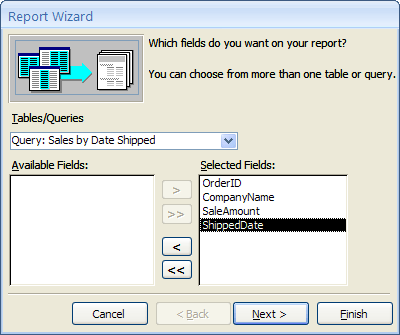
-
Click the Tables/Queries drop-downward list and cull the table or query that contains the fields y'all want on your report.
-
Double-click fields in the Bachelor Fields list to choose them.
Access moves them to the Selected Fields list. Alternatively, you can click the buttons located between the Available Fields box and the Selected Fields box to add or remove the selected field or to add all or remove all of the fields.
-
If in that location are fields in another table or query that you likewise want to put on your report, click the Tables/Queries drib-down list again and choose the other table or query, and continue to add together fields.
-
After you've finished adding fields, click Adjacent.
Grouping records in the Report Wizard
Group lets you organize and arrange records by grouping, such equally by Region or SalesPerson. Groups tin exist nested and then that you can easily place the relationships among the groups and find the information you want speedily. You can also apply group to calculate summary data, such as totals and percentages.
When yous include more than ane table in a study, the wizard examines the relationships between the tables and determines how yous might want to view the information.
-
On the page of the Report Magician that asks Do you lot want to add any grouping levels?, click one of the field names in the listing, and then click Next.
-
To add group levels, double-click any of the field names in the list to add them to your report.
Yous can also remove a grouping level past double-clicking it in the page display on the correct side of the dialog box. Utilize the arrow buttons to add together and remove group levels, and adjust the priority of a group level past selecting it and clicking the upwardly or down priority buttons. Admission adds each group level and shows it nested within its parent grouping level.
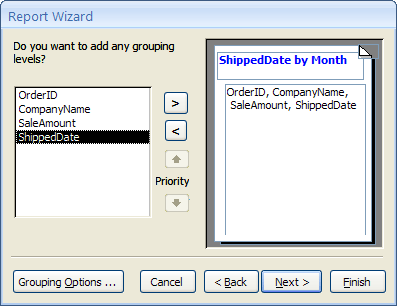
-
Click Grouping Options to display the Grouping Intervals dialog box.
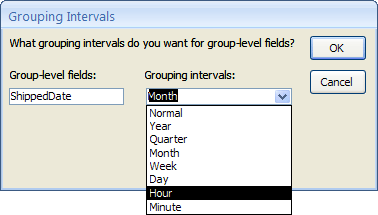
-
Optionally, for each group-level field, cull a group interval.
The group interval lets you lot customize how records are grouped. In the previous illustration, records are grouped on the ShippedDate field, which is a Date/Fourth dimension information type. The Study Sorcerer offers choices appropriate to the field type in the Grouping intervals list. Thus, because ShippedDate is a Appointment/Fourth dimension type, you can cull to group past actual value (Normal), Yr, Quarter, Calendar month, Week, Day, Hour and Minute. If the field were a Text data type, you could choose to group by the entire field (Normal), or perhaps past the outset one to five characters. For a numeric data type, you can choose to grouping by value (Normal), or past range in selected increments.
After selecting a grouping interval, click OK.
-
Click Next to navigate to the next folio of the wizard.
Sort and summarize records
You can sort records by upwardly to 4 fields, in either ascending or descending order.
-
Click the outset drop-down list and choose a field on which to sort.
You tin click the button to the right of the listing to toggle between ascending and descending club (Ascending is the default). Optionally, click the second, third, and 4th drib-downwardly lists to choose additional sort fields.
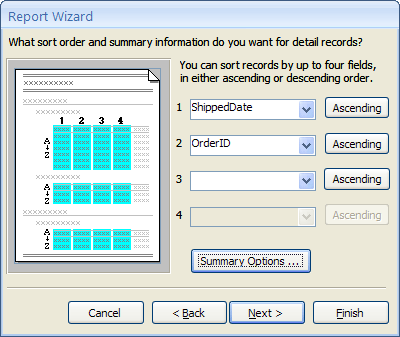
-
Click Summary Options if you want to summarize any of the numeric fields.
Note that the Summary Options button will but exist visible if you have one or more numeric fields in the Detail section your written report. The wizard displays the available numeric fields.
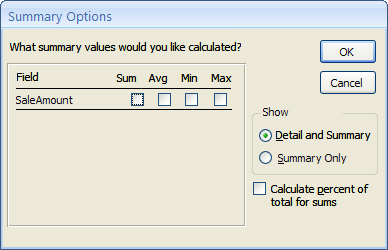
-
Select the cheque box under your choice of Sum, Avg, Min or Max to include those calculations in the group footer.
You can as well cull to evidence the details and summary or the summary only. In the latter example, totals for each ShippedDate value are shown (if you selected the check box for Sum, for instance), but the order detail is omitted. You tin likewise choose to show percent of full calculations for sums.
-
Click OK.
-
Follow the directions on the remaining pages of the Study Wizard. On the last page, you can edit the title of the report. This title will exist displayed on the first page of the report, and Admission volition also relieve the study, using the title as the document name. You can edit both the title and the document name afterwards.
-
Click Stop. Access automatically saves the written report and displays it in Print Preview, which shows you the report as it will wait when printed.
You can utilize the navigation buttons at the bottom of the preview pane to view the pages of the study sequentially or spring to any page in the report. Click one of the navigation buttons or blazon the folio number that y'all want to encounter in the folio number box, and and then press ENTER.
In Impress Preview, you can zoom in to see details or zoom out to see how well information is positioned on the page. With the mouse pointer positioned over the written report, click in one case. To opposite the effect of the zoom, click again. You can also use the zoom control in the status bar.
Add or change grouping and sorting in an existing study
If you accept an existing written report and you lot want to add together sorting or grouping to information technology, or if you want to change the study'south existing sorting or group, this section helps you get started.
Add together grouping, sorting, and totals
You can perform simple sorting, grouping and totaling operations by correct-clicking fields in Layout view and so choosing the operation yous desire from the shortcut menu. To switch to Layout view, right-click the report in the Navigation Pane and so click Layout view.
Note: Although the instructions in this section don't use the Group, Sort, and Total pane directly, it is a good thought to open the pane and observe how it changes equally you work. You will become a better thought of what Access is doing and, as you get more comfortable working with the Group, Sort, and Full pane, you tin use it to make additional adjustments to your written report. To display the Group, Sort, and Total pane:
-
On the Design tab, in the Grouping & Totals group, click Grouping & Sort.
Sort on a single field
-
Right-click any value in the field on which y'all desire to sort.
-
On the shortcut bill of fare, click the sort option y'all want. For example, to sort a text field in ascending lodge, click Sort A to Z. To sort a numeric field in descending order, click Sort Largest to Smallest.
Access sorts the report as you specified. If the Group, Sort, and Total pane is open up, you tin can see that a new Sort by line for the field has been added.
Sort on multiple fields
Note: When you use sorting past right-clicking a field in Layout view, you tin can only sort one field at a time. Applying sorting to another field removes the sorting on the offset field. This differs from the sorting behavior in forms, where multiple sort orders can exist established past right-clicking each field in turn and the choosing the sort gild yous want. To create multiple sorting levels, see the department Add grouping, sorting, and totals by using the Group, Sort, and Total pane.
Group on a field
-
Right-click whatsoever value in the field on which you want to group.
-
On the shortcut menu, click Group On.
Access adds the grouping level and creates a group header for it. If the Group, Sort, and Total pane is open, you tin encounter that a new Group on line for the field is added.
Add a total to a field
This option lets you summate a sum, average, count, or other amass for a field. A grand total is added to the cease of the report, and group totals are added to any groups that exist on the report.
-
Right-click any value in the field that you want to total.
-
Click Full.
-
Click the operation you lot would similar to perform: Sum, Boilerplate, Count Records (to count all records), Count Values (to count merely the records with a value in this field), Max, Min, Standard Deviation, or Variance.
Access adds a calculated text box control to the report footer, which creates a grand full. Also, if your report has whatsoever group levels, Access adds group footers (if not already present) and places the total in each footer.
Annotation: You tin can also add totals by clicking the field that you desire totaled and then, on the Design tab, in the Group & Totals group, click Totals.
Add group, sorting, and totals by using the Group, Sort, and Total pane
Working in the Group, Sort, and Total pane gives you the most flexibility when y'all want to add or change groups, sort orders, or totals options on a written report. Again, Layout view is the preferred view in which to work because it is much easier to see how your changes affect the brandish of the data.
Display the Group, Sort, and Total pane
-
On the Design tab, in the Grouping & Totals grouping, click Group & Sort.
Access displays the Grouping, Sort, and Total pane.
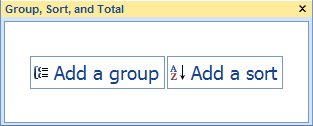
To add a new sorting or grouping level, click Add a grouping or Add a sort.
A new line is added to the Grouping, Sort, and Total pane, and a list of bachelor fields is displayed.
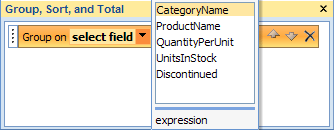
You can click i of these field names or y'all tin click expression below the list of fields to enter an expression. Once you choose a field or enter an expression, Access adds the group level to the study. In Layout view, the brandish changes immediately to testify the group or sort order.
For more data about creating expressions, come across the commodity Build an expression.
Notes:
-
If there are already several sorting or group levels defined, you may demand to curlicue downwards in the Group, Sort, and Total pane before you lot tin run across the Add a group and Add a sort buttons.
-
You tin define up to 10 grouping and sorting levels in a written report.
Alter grouping options
Each sorting or grouping level has a number of options that can be set up to obtain the results yous desire.

-
To display all the options for a grouping or sorting level, click More than on the level that you desire to change.

-
To hide the options, click Less.
Sort order You tin can change the sort gild past clicking the sort society drop-downward listing, then clicking the option yous want.
Group interval This setting determines how the records are grouped together. For case, you tin group on the start character of a text field so that all that showtime with "A" are grouped together, all that kickoff with "B" are grouped together, and and so on. For a date field, you tin group by day, week, month, quarter, or you lot can enter a custom interval.
Totals To add totals, click this selection. You can add together totals on multiple fields, and you can practice multiple types of totals on the same field.
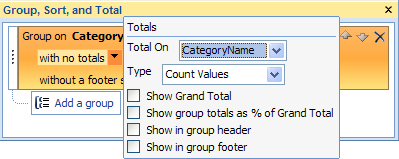
-
Click the Full On drib-downwards arrow and select the field yous want to have summarized.
-
Click the Blazon drop-down arrow and select the type of calculation to perform.
-
Select Show Grand Total to add a grand total to the finish of the report (in the report footer).
-
Select Show grouping totals as % of G Total to add a control to the group footer that calculates the percentage of the grand full for each group.
-
Select Show in group header or Show in group footer to display the full in the desired location.
Once all the options accept been chosen for a field, you can repeat the procedure and summarize another field by selecting the other field from the Total On drop-down list. Otherwise, click outside the Totals pop-up window to close it.
Title This allows you lot to change the title of the field being summarized. This is used for the column heading and for labeling summary fields in headers and footers.
To add or modify the title:
-
Click the blue text post-obit with title.
The Zoom dialog box appears.
-
Type the new title in the dialog box, and and then click OK.
With/without a header section Use this setting to add together or remove the header section that precedes each group. When adding a header section, Access moves the grouping field to the header for you. When y'all remove a header section that contains controls other than the grouping field, Access asks for confirmation to delete the controls.
With/without a footer section Use this setting to add or remove the footer section that follows each group. When y'all remove a footer section that contains controls, Access asks for confirmation to delete the controls.
Continue grouping together This setting determines how groups are laid out on the page when the report is printed. Y'all may desire to keep groups together every bit much equally possible to reduce the corporeality of page turning that is needed to see the entire group. However, this usually increases the corporeality of paper needed to print the study, because nearly pages will have some blank infinite at the bottom.
-
Exercise not keep group together on one folio Use this option if you are not concerned nearly groups beingness broken upward past folio breaks. For example, a group of 30 items may take 10 items on the bottom of i folio and the remaining 20 items at the top of the next page.
-
Keep whole group together on ane page This choice helps minimize the number of page breaks in a group. If a group cannot fit in the remaining space on a page, Access leaves that space blank and begins the group on the next page instead. Large groups may withal span multiple pages, but this selection minimizes the number of page breaks within the grouping as much as possible.
-
Keep header and first tape together on one page For groups with group headers, this ensures that the group header volition not impress by itself at the lesser of a page. If Access determines that there is not enough room for at least one row of data to be printed after the header, the group begins on the following page.
Change the priority of group and sorting levels
To change the priority of a grouping or sorting level, click the row in the Group, Sort, and Full pane then click the upwardly pointer or the down pointer on the right side of the row.
Delete group and sorting levels
To delete a group or sorting level, click the row you want to delete in the Grouping, Sort, and Total pane, and and then press DELETE or click the Delete button on the right side of the row. When you delete a grouping level, if the grouping field was in the group header or footer, Access moves it to the report'south Detail section. Any other controls that were in the group header or group footer are deleted.
Create a summary report (without record details)
If you lot desire to show only totals (that is, simply the information in header and footer rows), on the Blueprint tab, in the Grouping & Totals group, click Hibernate Details. Doing this hides the records at the side by side lower level of grouping, resulting in a much more compact presentation of the summary data. Although the records are hidden, the controls in the hidden department are not deleted. Click Hide Details over again to restore the Detail rows to the written report.
Top of folio
Source: https://support.microsoft.com/en-us/office/create-a-grouped-or-summary-report-f23301a1-3e0a-4243-9002-4a23ac0fdbf3
0 Response to "I Combine the Same Report How Do I Make It So I Dont Have to Do the Same Thing Over and Over Again"
Post a Comment